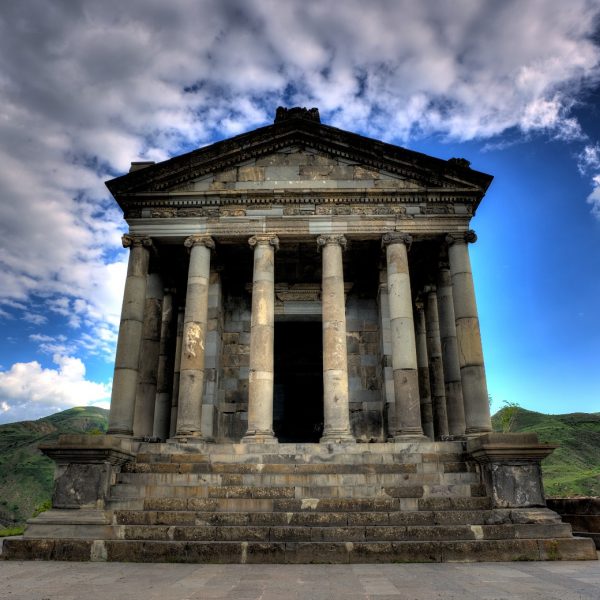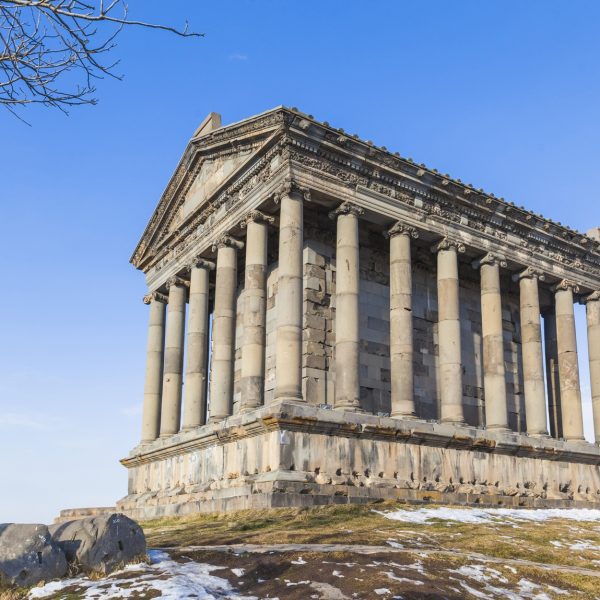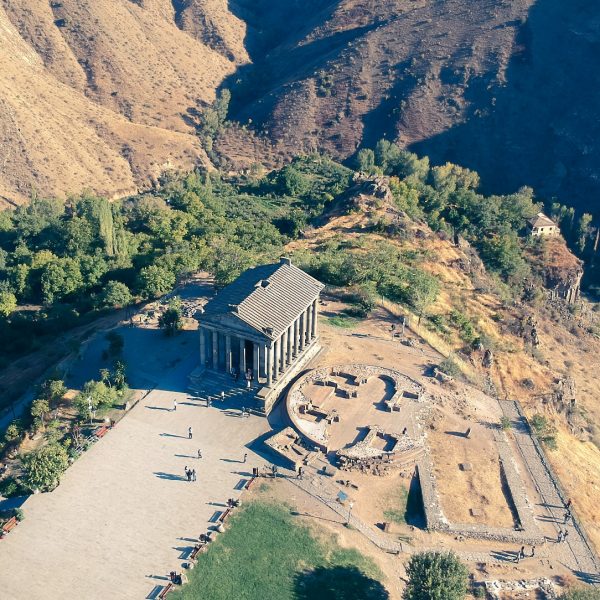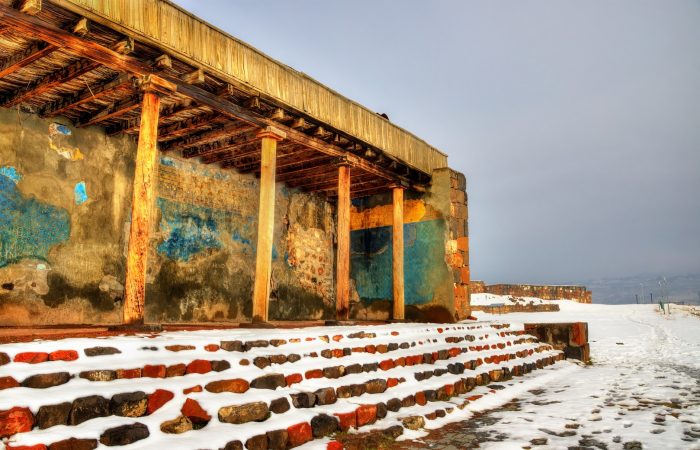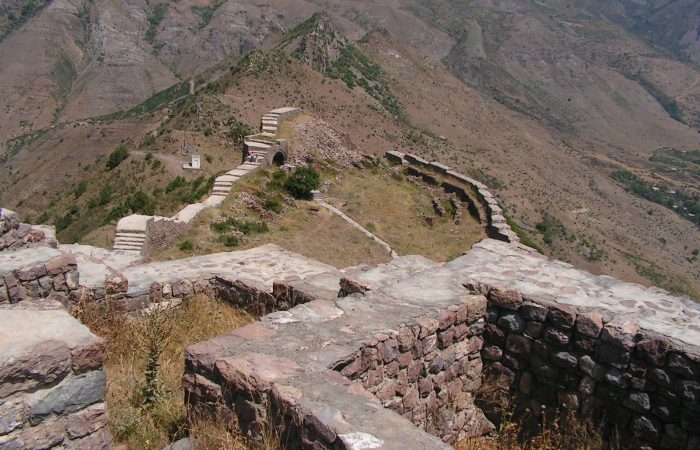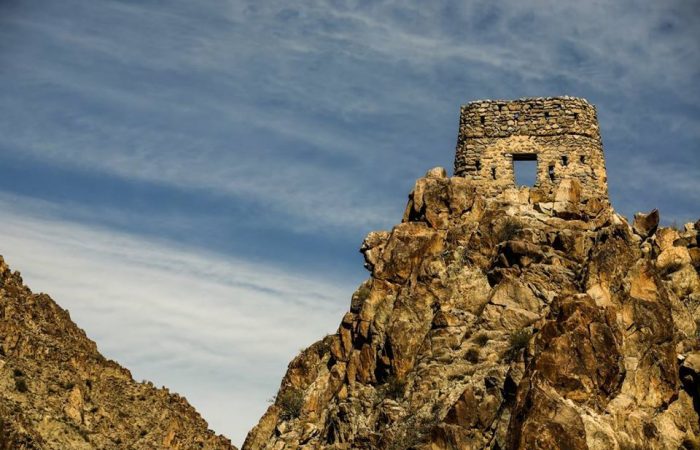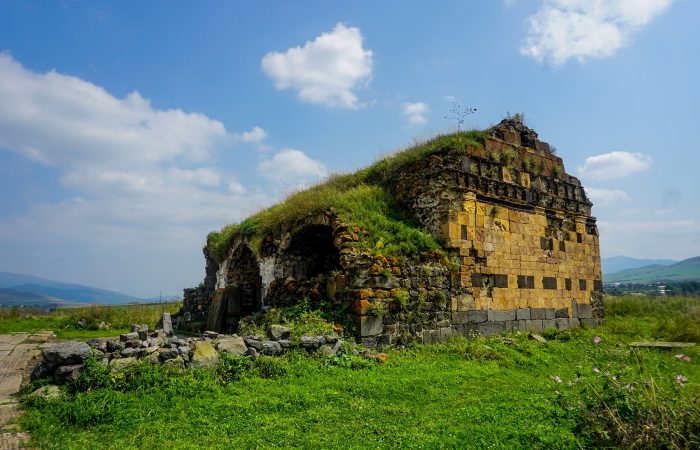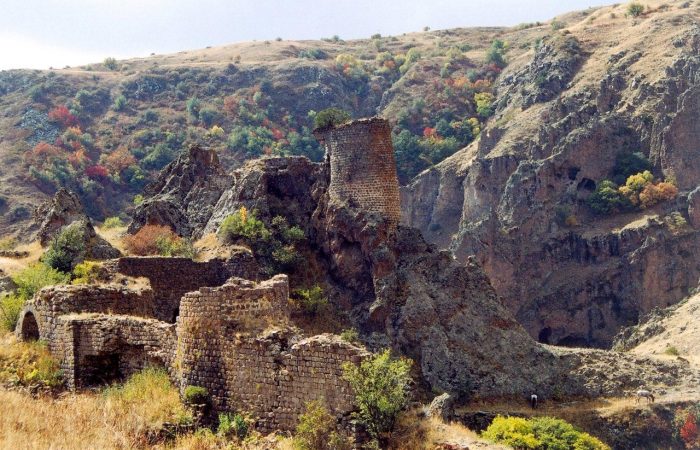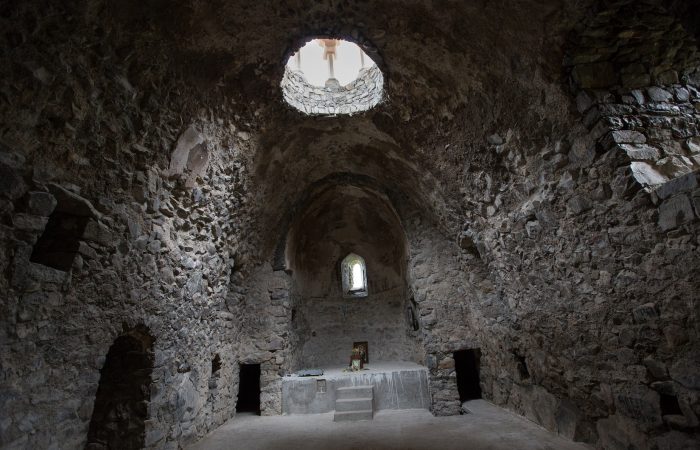Garni Fortress
There is no exact evidence as to when the fortress of Garni was founded. During archaeological excavations a Bronze Age settlement with dwellings and numerous items was discovered. In the Urartian period (8th-6th centuries BC) the walls of the fortress were reinforced and the prototype of the first century temple’s building was erected. The current arrangement of the fortress dates to the 3rd-2nd centuries BC when alongside with Alexander the Great’s Persian invasions Hellenistic culture spread into Armenia. Some of the outer walls and basements refer to exactly that period. Around 500 years later, that is during the reign of King Tiridates I, the temple of Mithra and the Roman baths were built. It was a period when the Romans were fighting against the Parthians to establish rule over the Middle East with Armenia being their battlefield.
In 54 Tiridates I defeated Rome’s candidate. It was then followed by the Roman invasion of Armenia (57). Capital Artashat was completely destroyed. Already in 62 Roman forces had occupied almost all Armenia but it was not the end since Armenian King Tiridates surrounded Roman troops and defeated them at Kharput (Kharberd). Facing pressure from Parthians Tiridates I was forced to make peace with the Romans and laid down his crown with the hope to get it in Rome. Upon receiving the crown from Roman Emperor Nero, Tiridates knelt before him and said, “Master, I have come to you to worship you like I worship Mithra. The destiny you have chosen for me shall be mine for you are my Fortune and Fate.”
Pliny the Elder recounted that Tiridates showed the Roman Emperor to magical rituals and that’s how cult of Mithra entered the Roman pantheon. To rebuild Armenia’s ruined capital city Nero allocated two million sesterces and sent Roman engineers. Tiridates named it Neronia after the Roman Emperor. In the meantime, in around 66 Tiridates ordered that the temple of Mithra be built in Garni. Later in 72 it was reconstructed and enlarged. Other than that, Tiridates also built a palace for his sister Khosrovadukht. An inscription in Greek in which Tiridates refers to himself as the “sun” (Helios) and the “Supreme Ruler of Greater Armenia” stands as a proof to that.
Garni Garrison
On the right side, upon a lower hill foundations dating back to the 3rd-4th centuries were found. The foundations were used as buildings to house the royal garrison. The garrison was to protect the royal family while it was in the residence as well as to ensure the royal family’s safety.
Garni Khatchkars (Stone Crosses)
The excavations carried out in the area revealed a number of khatchkars. Of interest is the dragon-stone dating to the Bronze Age. The cult of dragon was characteristic of the pre-Christian Armenia. Generally made of single-piece stone the dragons came in a fish-like form and were being placed at the water. Interestingly, they used to have a muscular tail with a snake, bull, stork and other animals on it. During the Christian period most of the dragon stones were destroyed or used as building materials to create the early period khatchkars or/and for church construction purposes.
The kahatchkars used to introduce the development of khatchkar art, from the early Christian period up to the Middle Ages.
The Founding Stone
The founding stone bearing Greek inscription states that the pagan temple and the palace were built in the first century. A line from the inscription reads, “Helios! The King of Greater Armenia, King Tiridates I built the palace for the Queen and the inaccessible castle in the eleventh year of his rule.”
Before the excavation there was no mention of the inscription. The significance of the inscription is explained by the fact it gives idea of when the temple was built.
Garni Temple: The Temple of Mithra
The Temple of Mithra, commonly referred to as Garni Temple, is the only wholly preserved sample of Hellenistic architecture in Armenia. The temple was ruined during an earthquake that occurred in 1679. The reconstruction works were launched only in the 20th century, more precisely in 1949. The temple was dedicated to Mithra. Mithra is the equivalent of the Greek word “Helios” meaning “Sun” or the “God of Sun.” In several sources, the temple is referred to as “Helios Temple.” The deity is believed to bear its origins in India, and to be spread in Persia and Armenia in the Bronze and Iron Ages in form of Zoroastrism. During the 3rd-2nd centuries BC Alexander the Great’s troops carried it to Greece, where its Manichean form was incorporated into the Greek concept of God Helios.
The Temple of Garni was built in the place of an Urartian Temple. It emulates the latter’s dimensions (5.05 x 7.98 meters). The temple represents a Greco-Roman peripeteros. Nine wide stairs take to the entrance of the temple. The sanctum is located there. The Arabic inscription at the entrance of the prayer hall informs about the capture of the fortress and the temple’s being turned into a mosque. The temple features 24 columns with six columns on the back and six on the front, and 8 columns on each of the two sides.
Garni Temple: Sacred Geometry
Ancestral Armenians used to build their lives in accordance with the rules of the nature, carefully studying the seasonal ebbs and flows controlling their lives. The prediction of spring thaws and summer rains was more than magic. It bore an immense significance for the surviving of the culture.
The sacred geometry, which the Pythagoreans had brought close to perfection, was widely used in the Middle East and Ancient Rome. The temple of Garni is the reflection of sacred geometry. If defined word for word, geometry means contact with the Gods. It was also the main tool to make items by hand. The idea behind sacred geometry was to re-unite the humanity with the cosmic whole. The sacred numbers carried symbolic meanings.
- One – Represented the universe.
- Two – Represented division.
- Three – Represented the Holy Trinity.
- Four – Represented the four seasons of the year.
- Five – In many cultures five symbolized misfortune, but among Greeks and Armenians it stood for the pentagram and symbolized creation (five fingers on the hand).
- Six – Represented perfection.
- Seven – Represented divinity and spiritual powers.
- Eight – Represented new life.
- Nine – Nine was the most sacred number (3×3).
The Temple of Garni is the reproduction of the universe’s structure. The 9 stairs take to the high pedestal (the heaven) and the main entrance (9 equals to 3×3 or 3 x Holy Trinity). The column to inner column ratio makes 1 to 3 (1 stands for the indivisible universe, while 3 for the Holy Trinity). The 24 columns represent the clouds or the vapor:
- 24-> 2+4=6 -> the perfect number
- 24->24=8×3, in sacred geometry it is interpreted as follows – new life multiplied by the Holy Trinity; the life granted by God.
Column arrangement: 6 columns on the back and 6 on the front – six symbolized perfection, while the 8 columns on each of the sides symbolized new life.
Also, it should be noted that the length of the horizontal lines inside the sanctuary always makes 5, while the length of the vertical lines – 8.
Saint Sion Church
Adjacent to the temple, the ruins of Saint Sion Church can be seen. It was built in 659. The ruins were discovered during the partial excavations carried out in 1907-1911, while during the 1949 excavations the main walls were completely uncovered. Considered as the copy of Zvartnots Church, Sion Church represents central church dome type with cross wings. Made of tufa stone, the church could be accessed from the South and the West.
Mashtots Hayrapet Church
Mashtots Hayrapet church is a central dome type small church. It was built upon the grave of Catholicos of All Armenians Mashtots I Eghivardetsi. To escape the Arab attacks the Holy See and its treasures were moved to Garni, where the Catholicos died and was buried. On the northern side of the church ruins of the Catholicos’s gravestone are preserved.
The Summer Palace
Known as the house of coolness the palace was designed in a way as to offer natural air conditioning. Back in those days it was performed by the following way: wet drapes were being hanged in the open column halls. With the help of the blowing wind those curtains used to cool off the inner rooms. The building consisted of the main building and outer building. Presently only the excavated building remains.
Argishti I Inscription
The cuneiform inscription dating to the 8th century BC was discovered during the 1954 excavations. It’s the most important finding in the area. It informs about the conquest of Garni and the capture of the people living there. The inscription reads, “By the Greatness of Khaldi, I conquered Giarniani, the land of the master of Siluni. After I returned from the highlands of my enemies I drove away men and women from there.”
Argishti I (785-763 BC) was the sixth king of the Urartian Kingdom.
Royal Baths
The bath represented a third century building with five rooms:
- Dressing room (apoditerium)
- Cold water bath (frigidarium)
- Warm room (tepidarium)
- Hot water room (caldarium)
- Steam Room (sudatorium)
The most interesting part of the bath building is the mosaic dating back the third century. It is made of natural stones featuring 15 various hues. The inscriptions on the mosaic are in Greek, while the images (fish, mermaids) have oriental facial types. One inscription made in Koine Greek if translated word-for-word means, “we didn’t get even a dead fish from the sea or the ocean.” In other words, it would sound as follows, “We worked without any pay.”
Lastly to visit this historical sight you have to pay an admission fee. For kids it makes up 100 Dram, for adults 250 Dram, while for tourists 1000 Dram. Guided tours are also available at 1500 Dram. The fortress is open year round: during summertime from 10 am to 9 pm, while during wintertime from 10 am to 5 pm.

